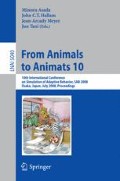Abstract
We present a novel approach to self-organisation of coordinated behaviour among multiple resource-sharing agents. We consider a hierarchical multi-agent system comprising multiple energy-dependent agents split into local neighbourhoods, each with a dedicated controller, and a centralised coordinator dealing only with the controllers. The coordinated behaviour is required in order to achieve a balance between the overall resource consumption by the multi-agent collective and the stress on the community. Minimising the resource consumption increases the stress, while reducing the stress may lead to unrestricted and highly unpredictable demand, harming the individual agents in the long-run. We identify underlying forces in the system’s dynamics, suggest a number of quantitative measures used to contrast different strategies, and introduce a novel strategy based on persistent sensorimotor time-loops: homeotaxis. Homeotaxis subsumes the homeokinetic principle, extending it both in terms of scope (multi-agent self-organisation) and the state-space, and allows to select the best adaptive strategy for the considered system.
Access this chapter
Tax calculation will be finalised at checkout
Purchases are for personal use only
Preview
Unable to display preview. Download preview PDF.
References
Ashby, W.R.: Design for a Brain. Chapman and Hill, London (1954)
Ay, N., Bertschinger, N., Der, R., Güttler, F., Olbrich, E.: Predictive information and explorative behavior of autonomous robots. European Journal of Physics: Complex Systems (submitted, 2007)
Baldassarre, G.: Self-organization as phase transition in decentralized groups of robots: A study based on boltzmann entropy. In: Prokopenko, M. (ed.) Advances in Applied Self-organizing Systems, pp. 127–146. Springer, Heidelberg (2007)
Der, R.: Self-organized robot behavior from the principle of homeokinesis. In: Proceedings of the SOAVE Workshop, Ilmenau (2000)
Der, R., Güttler, F., Ay, N.: Predictive information and emergent cooperativity in a chain of mobile robots. Santa Fe Institute Working Paper 08-02-006 (2008)
Der, R., Hesse, F., Martius, G.: Rocking stamper and jumping snake from a dynamical system approach to artificial life. J. Adaptive Behavior 14, 105–116 (2005)
Der, R., Liebscher, R.: True autonomy from self-organized adaptivity. In: Proceedings of The Workshop on Biologically Inspired Robotics, The Legacy of W. Grey Walter, August 14-16, 2002, HP Bristol Labs (2002)
Klyubin, A.S., Polani, D., Nehaniv, C.L.: All else being equal be empowered. In: Capcarrère, M.S., Freitas, A.A., Bentley, P.J., Johnson, C.G., Timmis, J. (eds.) ECAL 2005. LNCS (LNAI), vol. 3630, pp. 744–753. Springer, Heidelberg (2005)
Li, R., Poulton, G.: Optimal management of multiple resource consuming devices during periods of supply restriction. Technical report, CSIRO ICT Centre, Macquarie University (May 2007)
Lizier, J.T., Prokopenko, M., Zomaya, A.Y.: Local information transfer as a spatiotemporal filter for complex systems. Phys. Rev. E 77, 026110 (2008)
Mirollo, R., Strogatz, S.: Synchronization of pulse-coupled biological oscillators. SIAM Journal of Applied Math 50, 1645–1662 (1990)
Odhner, L., Ueda, J., Asada, H.: Broadcast feedback of stochastic cellular actuators. In: Proc. of The 10th International Symposium on Experimental Robotics (ISER), Rio de Janeiro (2006)
Patel, A., Degesys, J., Nagpal, R.: Desynchronization: The theory of self-organizing algorithms for round-robin scheduling. In: Proceedings of The First IEEE Conference on Self-Adaptive and Self-Organizing Systems (SASO), pp. 87–96 (2007)
Piraveenan, M., Polani, D., Prokopenko, M.: Emergence of genetic coding: an information-theoretic model. In: eCosta, F.A., Rocha, L.M., Costa, E., Harvey, I., Coutinho, A. (eds.) ECAL 2007. LNCS (LNAI), vol. 4648, pp. 42–52. Springer, Heidelberg (2007)
Prokopenko, M.: Design vs self-organization. In: Prokopenko, M. (ed.) Advances in Applied Self-organizing Systems, pp. 3–17. Springer, Heidelberg (2007)
Prokopenko, M., Gerasimov, V., Tanev, I.: Evolving spatiotemporal coordination in a modular robotic system. In: Nolfi, S., Baldassarre, G., Calabretta, R., Hallam, J.C.T., Marocco, D., Meyer, J.-A., Miglino, O., Parisi, D. (eds.) SAB 2006. LNCS (LNAI), vol. 4095, pp. 558–569. Springer, Heidelberg (2006)
Trianni, V., Nolfi, S.: Minimal communication strategies for self-organising synchronisation behaviours. In: Proceedings of The First IEEE Symposium on Artificial Life, pp. 199–206 (2007)
Werner-Allen, G., Tewari, G., Patel, A., Nagpal, R., Welsh, M.: Firefly-inspired sensor network synchronicity with realistic radio effects. In: Proceedings of The Third ACM Conference on Embedded Networked Sensor Systems (SenSys), San Diego, pp. 142–153 (2005)
Wikipedia,: Taxis — wikipedia, the free encyclopedia (2007) [Online; accessed January 10, 2008]
Author information
Authors and Affiliations
Editor information
Rights and permissions
Copyright information
© 2008 Springer-Verlag Berlin Heidelberg
About this paper
Cite this paper
Prokopenko, M., Zeman, A., Li, R. (2008). Homeotaxis: Coordination with Persistent Time-Loops. In: Asada, M., Hallam, J.C.T., Meyer, JA., Tani, J. (eds) From Animals to Animats 10. SAB 2008. Lecture Notes in Computer Science(), vol 5040. Springer, Berlin, Heidelberg. https://doi.org/10.1007/978-3-540-69134-1_40
Download citation
DOI: https://doi.org/10.1007/978-3-540-69134-1_40
Publisher Name: Springer, Berlin, Heidelberg
Print ISBN: 978-3-540-69133-4
Online ISBN: 978-3-540-69134-1
eBook Packages: Computer ScienceComputer Science (R0)

